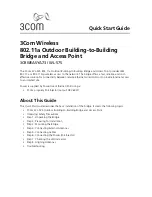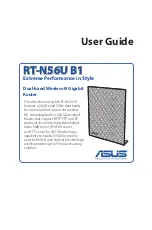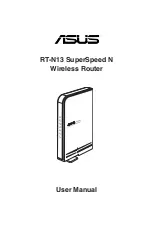
Introduction
1-3
1.1.1 IP Filtering
IP filtering determines which IP packets are processed normally and which are discarded. If discarded,
the packet is deleted and completely ignored (as if never received). Optionally apply different criteria
to better refine which packets to filter.
IP filtering supports the creation of up to 20 filter rules enforced at layer 3. Once defined (using the
access point’s SNMP, GUI or CLI), filtering rules can be enforced on the access point’s LAN1, LAN2
and WLAN interfaces. An additional default action is also available denying traffic when the filter
rules fail. Lastly, imported and exported configurations retain their defined IP filtering configurations.
For information on configuring the access point’s IP filtering functionality, see
.
1.1.2 MU Rate Limiting
MU rate limiting enables an administrator to determine how much radio bandwidth is allocated to
each MU within any one of the 16 supported WLANs.
Before this 4.0 baseline release, Motorola Solutions access points supported bandwidth
management on a per-WLAN basis. Each WLAN could be configured to receive (at most) a certain
percentage of the total available downstream bandwidth. The new rate limiting feature is a
replacement of the bandwidth management feature allowing for better MU radio bandwidth
allotments on a per WLAN basis.
To globally enable or disable the MU rate limit and assess the WLANs in which it’s currently invoked,
see
Configuring MU Rate Limiting on page 5-67
.
To define the actual MU rate limit (maximum downstream bandwidth allocation in kbps), see
Creating/Editing Individual WLANs on page 5-29
1.1.3 Per Radio MU Limit
Prior to this new 4.0 AP firmware baseline, an access point allowed a total of 127 MU associations,
regardless of the number of radios on the AP. With a dual-radio AP, if there were already 127 MUs
associated to one radio, that were no slots available for a MU to associate with another radio.
With the new 4.0 firmware, an AP can reserve slots on each radio so MUs of one radio type (11a/n
or 11bg/n) have better chances for AP association. Therefore, the total number of MUs allowed to
associate remains at 127, but you can now strategically distribute the 127 MU associations between
the data radios.
Summary of Contents for P-7131N-FGR
Page 1: ...Motorola Solutions AP 7131N FGR Product Reference Guide M ...
Page 3: ...AP 7131N FGR Access Point Product Reference Guide ...
Page 4: ......
Page 14: ...Motorola Solutions AP 7131N FGR Access Point Product Reference Guide 10 ...
Page 46: ...Motorola Solutions AP 7131N FGR Access Point Product Reference Guide 1 30 ...
Page 57: ...Hardware Installation 2 11 ...
Page 70: ...Motorola Solutions AP 7131N FGR Access Point Product Reference Guide 2 24 ...
Page 90: ...Motorola Solutions AP 7131N FGR Access Point Product Reference Guide 3 20 ...
Page 224: ...Motorola Solutions AP 7131N FGR Access Point Product Reference Guide 5 78 ...
Page 296: ...Motorola Solutions AP 7131N FGR Access Point Product Reference Guide 6 72 ...
Page 692: ...Motorola Solutions AP 7131N FGR Access Point Product Reference Guide B 10 ...
Page 699: ......
















































